Serving 814 students in grades 5-6, Lineville Intermediate ranks in the top 30% of all schools in Wisconsin for overall test scores (math proficiency is top 30%, and reading proficiency is top 30%).
The percentage of students achieving proficiency in math is 53% (which is higher than the Wisconsin state average of 39%). The percentage of students achieving proficiency in reading/language arts is 45% (which is higher than the Wisconsin state average of 38%).
The student:teacher ratio of 13:1 is equal to the Wisconsin state level of 13:1.
Minority enrollment is 16% of the student body (majority Hispanic), which is lower than the Wisconsin state average of 33% (majority Hispanic).
Quick Stats (2025)
- Grades: 5-6
- Enrollment: 814 students
- Student:Teacher Ratio: 13:1
- Minority Enrollment: 16%
- Overall Testing Rank: Top 30% in WI
- Math Proficiency: 53% (Top 30%)
- Reading Proficiency: 45% (Top 50%)
- Source: National Center for Education Statistics (NCES), WI Dept. of Education
School Overview
Lineville Intermediate's student population of 814 students has declined by 10% over five school years.
The teacher population of 63 teachers has grown by 6% over five school years.
Grades Offered
Grades 5-6
(offers virtual instruction)
(offers virtual instruction)
Total Students
814 students

Gender %
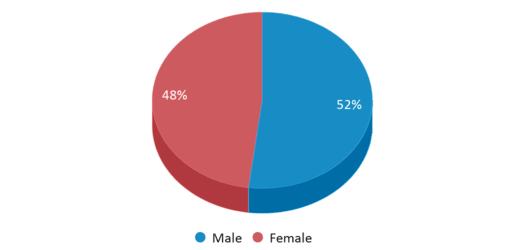
Total Classroom Teachers
63 teachers

Students by Grade
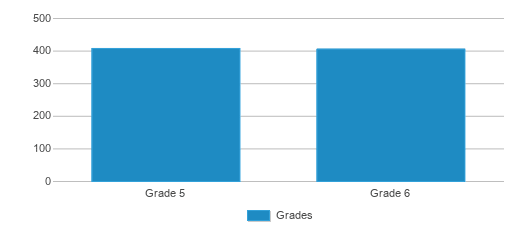
School Rankings
Lineville Intermediate ranks within the top 30% of all 1,991 schools in Wisconsin (based off of combined math and reading proficiency testing data).
The diversity score of Lineville Intermediate is 0.29, which is less than the diversity score at state average of 0.53. The school's diversity has stayed relatively flat over five school years.
Overall Testing Rank
#537 out of 1991 schools
(Top 30%)
(Top 30%)
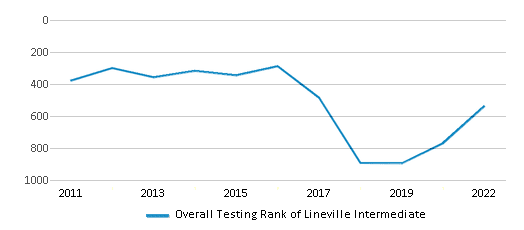
Math Test Scores (% Proficient)
53%
39%
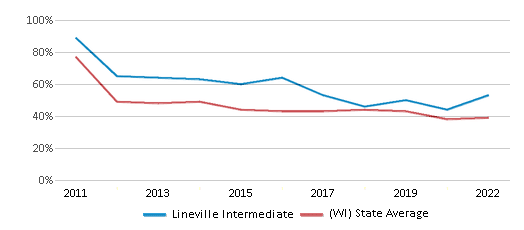
Reading/Language Arts Test Scores (% Proficient)
45%
38%
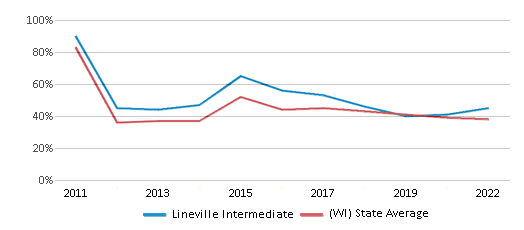
Student : Teacher Ratio
13:1
13:1
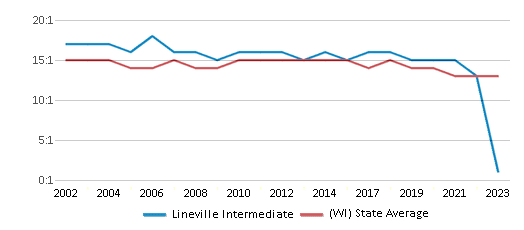
American Indian
1%
1%
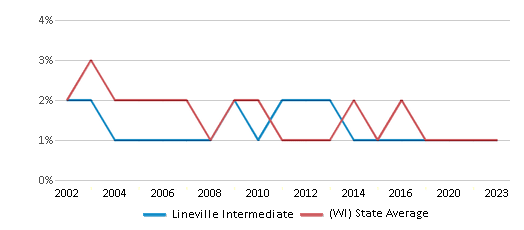
Asian
3%
4%
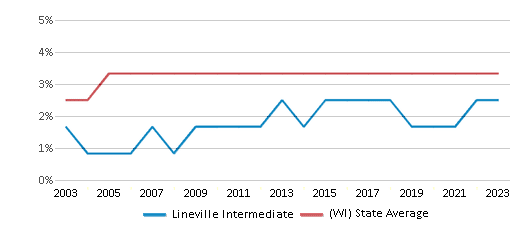
Hispanic
6%
14%
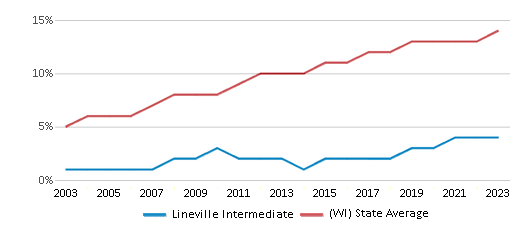
Black
1%
9%
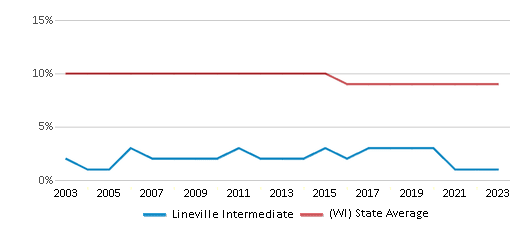
White
84%
67%
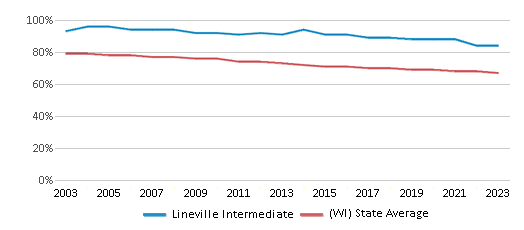
Hawaiian
n/a
n/a
Two or more races
5%
5%
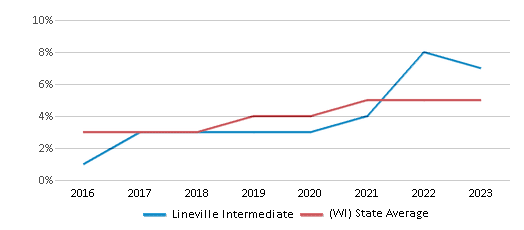
All Ethnic Groups
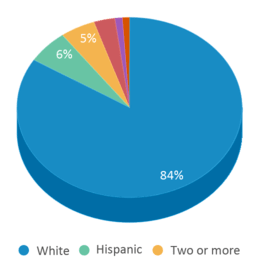

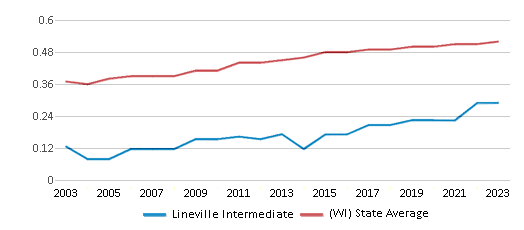
Participates in the National School Lunch Program (NSLP)
Yes
Eligible for Free Lunch
18%
37%

Eligible for Reduced Lunch
5%
4%

School Statewide Testing
School District Name
Source: National Center for Education Statistics (NCES), WI Dept. of Education
Profile last updated: 02/09/2025
Frequently Asked Questions
What is Lineville Intermediate's ranking?
Lineville Intermediate is ranked #537 out of 1,991 schools, which ranks it among the top 30% of public schools in Wisconsin.
What percent of students have achieved state testing proficiency in math and reading?
53% of students have achieved math proficiency (compared to the 39% WI state average), while 45% of students have achieved reading proficiency (compared to the 38% WI state average).
How many students attend Lineville Intermediate?
814 students attend Lineville Intermediate.
What is the racial composition of the student body?
84% of Lineville Intermediate students are White, 6% of students are Hispanic, 5% of students are Two or more races, 3% of students are Asian, 1% of students are American Indian, and 1% of students are Black.
What is the student:teacher ratio of Lineville Intermediate?
Lineville Intermediate has a student ration of 13:1, which is equal to the Wisconsin state average of 13:1.
What grades does Lineville Intermediate offer ?
Lineville Intermediate offers enrollment in grades 5-6 (offers virtual instruction).
What school district is Lineville Intermediate part of?
Lineville Intermediate is part of Howard-Suamico School District.
School Reviews
2 7/6/2015
Though the curriculum is strong and its always been know as a school within a district of quality education some where along the line its lost its focus on the social growth of its students. And in my experience (I can only speak from my family experience) not all students are treated fairly. Being different is just barely tolerated with in its student body. And though I can not fault young adults wholy for flaws in their ability to interact with and except those that are different I can, however, fault the staff. It is their job to guide students to except people in all walks of life. Our family did not fit the majority demographic of this school and it always felt as though there was a sort of 'in-group' between parents and staff. Falling outside of this group left our child in a funny place where she was not excepted among their peers and was subject bullies and indifferent staff. Some going as far as telling our child it something she will just need to deal with and making no attempt at steer the our child and students involved onto the correct path. It was heartbreaking to be a part of. With that said, Lineville has some great teachers and staff but the school, as a whole, could benefit from training in tolerance, respect and kindness both for students and staff. We eventually pulled our child out of the district and watched their social growth explode positively with proper leadership in a different district. I was back and forth on whether or not to write this review for months, my only goal is to help by relaying my experience. Thank you for reading.
Review Lineville Intermediate. Reviews should be a few sentences in length. Please include any comments on:
- Quality of academic programs, teachers, and facilities
- Availability of music, art, sports and other extracurricular activities
Recent Articles

What Is A Charter School?
Explore the world of charter schools in this comprehensive guide. Learn about their history, how they operate, and the pros and cons of this educational innovation. Discover key facts about charter schools, including admission policies, demographics, and funding, as well as what to look for when considering a charter school for your child.

10 Reasons Why High School Sports Benefit Students
Discover the 10 compelling reasons why high school sports are beneficial for students. This comprehensive article explores how athletics enhance academic performance, foster personal growth, and develop crucial life skills. From improved fitness and time management to leadership development and community representation, learn why participating in high school sports can be a game-changer for students' overall success and well-being.

February 05, 2025
Understanding the U.S. Department of Education: Structure, Impact, and EvolutionWe explore how the Department of Education shapes American education, from its cabinet-level leadership to its impact on millions of students, written for general audiences seeking clarity on this vital institution.









